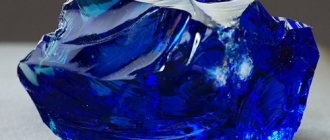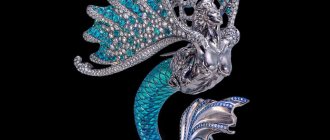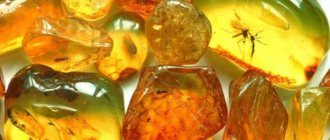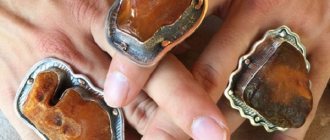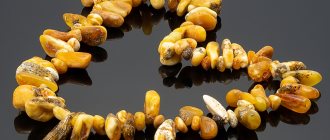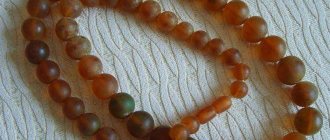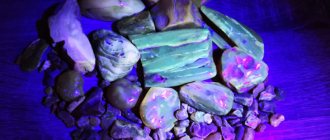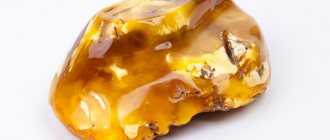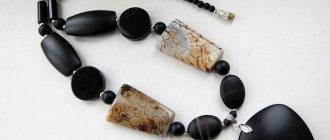Blue amber is an amazing and rare gemstone, recognizable by its deep blue glow. This species can only be found in the Dominican Republic and, to a small extent, in Indonesia and Mexico.
In the 1990s, Dominican amber suddenly came under the spotlight due to Steven Spielberg's Jurassic Park, especially those with insects frozen inside - more on that later. The first thing that catches your eye when looking at a scattering of blue amber is the variety of color palette.
The stone is not blue to the naked eye; in artificial light it is difficult to distinguish it from ordinary Baltic amber, but under the rays of the sun it gives off an intense blue glow.
How did the sun stone come about?
The secret of the blue hue is hidden in the unique conditions of origin of the stone. The source of Dominican blue amber was the resin of Hymenaea Protera, a carob tree that became extinct millions of years ago.
Research shows that blue amber is between 25 and 15 million years old.
But its descendant, ceratonia, a tree of the legume family, has been preserved in East Africa. This tree produces a very small amount of resin, which settles in the soil around it. Having studied the properties of this tree, scientists suggested that a natural disaster occurred in the Dominican Republic many millions of years ago, destroying an entire forest. The resin of the burnt trees mixed with volcanic ash, after which it gradually sank to the bottom of the ocean. Under water pressure over millions of years, the resin was transformed into amber stones in a rich spectrum of shades of blue. After a new stage of tectonic shifts, the island rose again, and the mineral became available.
Blue amber stone
The uniqueness of Dominican stone
The blue gem makes a stunning and mesmerizing impression with the iridescence of its shades and colors. Looking at it, one gradually comes to understand that the mineral resembles our blue planet floating in the black cosmic abyss.
Dominican stone is the most unique among the varieties of amber because:
- it is the most durable and much more transparent than the Baltic one;
- Only about 50 kg of it is mined in a single mine in Haiti;
- when heated, blue amber smells like flowers, unlike ordinary amber, which emits the aroma of pine needles;
- fluorescence is another unique property that occurs due to the presence of inclusions of volcanic ash in the stone;
- when heated, the mineral turns green, and when heated again, it turns blue again. Scientists have not yet fully understood this amazing process;
- almost every piece of the blue mineral contains inclusions, in contrast to the Baltic specimens, for which inclusions are relatively rare.
Buying rare blue Dominican amber will be a wonderful acquisition not only because of its uniqueness and beauty. Each piece contains the history and energy of the Earth, a piece of it that was created over many millions of years.
Captives of the Sunstone
The marine origin of the stone also explains the large number of inclusions in blue amber, several times greater than the volume of included Baltic stones. Compare - inclusions are found in every hundredth blue stone, while among Baltic stones a surprise is found only in every thousandth. When imprisoned, jewelry is often found not only by insects and flowers, but also by mollusks, algae or fish teeth. There are even specimens with ancient frogs and lizards.
Dominican blue amber
Apparently, the resin remained soft for some time even in water. This property makes the stones desirable exhibits in any collection. To preface the question, no, you cannot extract DNA from them and recreate a dinosaur park.
What is the mystery of blue amber?
This amazing stone attracts the eye, shimmering with all shades of blue and blue, shining with white, yellow, red, green and even purple highlights!
But the most amazing and mysterious thing is the bluish glow of the Dominican stone, with which it glows under the influence of ultraviolet rays.
That is, if the stone lies in the shade or indoors, it has one shade, but once it is in the sun, you will see how it changes!
What is the reason for these amazing properties?
In the unique mineralogical composition that blue amber has, namely the presence of the substance “perylene” in the stone’s composition. Perylene is a chemical compound whose concentration affects the refractive spectrum of rays. Scientists explain the appearance of perylene by prolonged heating of hardening resin in an oxygen-free environment. The more perylene in amber, the richer the shade.
Origin story
In the 15th century, Christopher Columbus in his notes mentioned meeting blue amber on the island of Hispaniola (the ancient name for Haiti). The Aborigines offered the captain shoes beautifully decorated with blue amber in exchange for a strand of European beads. At that time, fossil minerals were not of particular value, and the Spaniards were not interested in the curiosity.
Amber blue
Archaeological excavations have revealed many other blue amber products on the island - carvings and jewelry. Today, Dominican blue amber has become the most valuable material for jewelry.
Production
Mining of blue amber began only in the 1960s, when gold was losing its relevance. During the first few years of mining, European involvement and export volumes were a concern for the Dominican government. In 1979, a law was passed banning the export of gemstones mined by foreign companies. Ten years later, a law prohibited the export of any amber containing animal or insect inclusions without the approval of the Natural History Museum.
Blue mineral
Most of the stones are mined in the Palo Quemadomine mine. Using primitive tools - shovels and short picks, workers manually comb the rock in search of jewelry. Collapses often occur in mines, and accidents claim many victims. Despite the lack of minimum safety conditions, there are people willing to work in the mines - with an average salary in the region of about $80, miners receive $85–500 a week.
Use in jewelry
Unique properties, rare origin and complexity of cutting make Dominican blue amber one of the most expensive jewelry in the world. Alas, only 50 kg of this precious stone is mined per year. Compared to 20 tons of diamonds, you can understand why blue amber is found only in luxury jewelry.
Ring with blue amber
Blue amber is harder than other types of fossilized resins, so only the most experienced craftsmen undertake to work with it. Jewelry replenishes the collections of the richest people in the world. Interestingly, in the Middle East the jewel is especially prized for its blue Misbahi prayer beads and is used in expensive rosaries.
Dominican amber
After processing, blue amber also exhibits phosphorescent properties and begins to emit a milky blue glow.
The most amazing examples can be seen at the Amber Museum in Puerto Plata. Here you can see natural masterpieces, the history of the origin of amber, and there is a gift shop at the end where you can buy souvenirs and jewelry.
Jewelry with blue amber
In jewelry stores, the cost of jewelry starts from $500. There are cheaper handicraft jewelry in the markets, but the risk of running into a fake increases. The raw stone will be sold right next to the mining site. From residents of the north of the Dominican Republic, you can bargain for a blue stone the size of a fist for $300.
We recommend watching the video, which tells about the most expensive blue amber.
Application
Of course, the main use of such a rare stone is the jewelry industry. A variety of jewelry is created from blue amber: earrings, beads, pendants and pendants, brooches, bracelets, rings, cufflinks, tie clips and many others.
In addition, various decorative and household items can be made from blue amber: dishes, coasters, figurines, chess, balls, combs, massagers, paintings and icons, souvenirs, rosaries, key rings, pens, etc.
The stone lends itself very well to processing and polishing, and therefore after all the manipulations it looks very beautiful.
How to spot a fake
Imitation is the best form of flattery. Recently, a new product called “Caribbean amber” has appeared on the world market for jewelry raw materials. It is quite transparent and has a greenish tint. Many speculate that it is a relative of Dominican bluestone from neighboring Caribbean islands. However, a careful examination of this “new” gemstone reveals that it is Colombian copal, treated and aged in a special way.
Products with stone
Fortunately, checking the original for authenticity is not too difficult and anyone can distinguish a fake.
- Salt water test. Place a pebble in salt water, the real one will float, but the plastic replicas will sink.
- Friction test. Amber has electrostatic properties, so if you rub the gemstone for 20-60 seconds and hold it to your hair, it should create a small amount of static electricity and the hair should stick to the stone. If the gemstone does not charge and instead becomes sticky, it means it is copal - young, immature amber.
- Smell test. When heated, any amber emits a pleasant smell. But if an ordinary Baltic stone smells of smoky pine, then real blue amber will surprise you with the smell of a blooming garden.
Properties of the stone
If ordinary yellow amber carries the energy of the sun, then blue amber is the power of air. Many cultures attribute magical properties to amber:
- stabilizes mental balance;
- increases luck;
- clears the mind;
- dissolves negative energy;
- clears the mind and gives wisdom.
In the Middle Ages, blue amber was credited with medicinal properties and was prescribed to treat asthma, gout and the black plague.
Blue amber from the Dominican Republic
In astrology, blue amber is considered the ancestor of the Cancer zodiac sign, since it accumulates the power of the sunniest air sign. It is also perfect for all zodiacs of the water and air elements - Libra, Aquarius, Scorpio, Cancer, Pisces and Gemini.
It is recommended to wear the stone in the form of pendants or in earrings - this will provide an influx of calm and warm energy to the owner.
Benefits of amber
Even in ancient times, amber was called the “stone of the sun” and they believed in its extremely beneficial effect on the human body.
Amber is believed to have:
- Anti-inflammatory effect. (in the old days it was applied to a sore spot to relieve pain and inflammation);
- Antibacterial properties (amber was recommended to be worn for the rapid healing of purulent and deep wounds);
- Fills the body with strength and energy (yellow amber is a stone of the sun, and blue is endowed with heavenly energy. This helps to cope with fatigue and maintain mental balance. Those who often suffer from headaches are recommended to wear amber on their heads);
- Helps preserve youth and beauty (there are even cosmetics containing succinic acid, which is a powerful preservative.)
Well, if we turn to esoteric teachings, then it is customary to attribute all sorts of magical properties to amber:
- protection from evil spirits;
- protection from nightmares and bad dreams;
- talisman for pregnant women and babies.
That is why amber figurines and beads are often used as a talisman.
As for astrologers, they claim that amber can be worn by all signs of the zodiac, without exception, but most of all the stone is suitable for the signs of the heavenly and water elements:
- Scorpios
- cancer
- scales
- Aquarius
- twins
- fish
Jewelry Care
Blue amber, like regular amber, needs special care. Often, upon contact with oxygen, a series of small “webs” form on the surface of the stone. It looks as if it fell and began to crack internally. Such cracks can be polished (by cutting off 3 or 4 millimeters from the surface).
Blue stone
In addition, jewelry may darken with age. Old amber usually takes on a reddish hue. This is thought to be due to oxidation. But you shouldn’t be upset about this - darkening only increases the cost of the jewelry.
To slow down the aging of a stone, it is enough to regularly treat its surface with oil - it prevents the surface from oxidizing when exposed to air. Paradoxically, regularly wearing blue amber jewelry also prolongs their life. The natural oils of the leather will coat the jewelry and slow down the oxidation process, thereby continuing to please the owner for many years to come.
Video about Dominican amber - the most abundant one discovered in the eastern part of the island of Haiti (Caribbean Sea) in the Dominican Republic.
